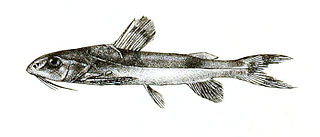
Trichomycteridae is a family of catfishes commonly known as pencil catfishes or parasitic catfishes. This family includes the candiru fish, feared by some people for its alleged habit of entering into the urethra of humans. They are one of the few parasitic chordates. Another species is the life monsefuano which was important to the Moche culture and still an important part of Peruvian cuisine.

The Pimelodidae, commonly known as the long-whiskered catfishes, are a family of catfishes.

The Doradidae are a family of catfishes also known as thorny catfishes, raphael catfishes or talking catfishes. These fish are native to South America, primarily the Amazon basin and the Guianas.

The Cetopsidae are a small family of catfishes, commonly called the whale catfishes.

The Ariidae or ariid catfish are a family of catfish that mainly live in marine waters with many freshwater and brackish water species. They are found worldwide in tropical to warm temperate zones. The family includes about 143 species.
Listrura is a genus of pencil catfishes native to South America.

Erethistidae are a family of catfishes that originate from southern Asia. It includes about 45 species.

Akysis is the largest genus of catfishes of the family Akysidae.
Malacoglanis gelatinosus is a species of catfish of the family Trichomycteridae, and the only species of the genus Malacoglanis. This fish grows to about 2.0 centimetres (.79 in) SL. and is native to the Caquetá River basin of Colombia. Stauroglanis is the sister group to a monophyletic group formed by Malacoglanis and Sarcoglanis.
Sarcoglanis simplex is a species of catfish of the family Trichomycteridae, and the only species of the genus Sarcoglanis. This fish originates from the upper Rio Negro basin of Brazil. Stauroglanis is the sister group to a monophyletic group formed by Malacoglanis and Sarcoglanis.
Trichogenes longipinnis, is a species of catfish of the family Trichomycteridae. T. longipinnis is endemic to coastal streams in the Atlantic forest between Rio de Janeiro and São Paulo States in southeastern Brazil.
Stauroglanis gouldingi is a species of catfish of the family Trichomycteridae, and the only species of the genus Stauroglanis.
Ammoglanis is a genus of pencil catfishes native to South America.
Microcambeva is a genus of catfishes of the family Trichomycteridae.

Gogangra is a genus of sisorid catfishes native to Asia.
Pygidianops is a genus of pencil catfishes native to South America.
Typhlobelus is a genus of pencil catfishes native to South America.
The Glanapteryginae are a subfamily of catfishes of the family Trichomycteridae. It includes four genera, Glanapteryx, Listrura, Pygidianops, and Typhlobelus.
Ammoglanis pulex is a species of pencil catfish found in the Paria Grande River, the Pamoni River, and the Caño Garrapata in Venezuela. This species reaches a length of 1.5 cm (0.59 in).
Ammoglanis diaphanus is a species of pencil catfish is found in a stream tributary to Javaés River, in the Araguaia River basin in Brazil. This species reaches a length of 1.9 cm (0.75 in).







